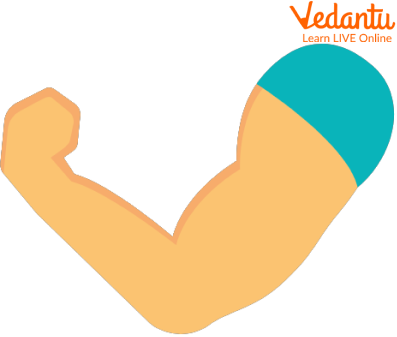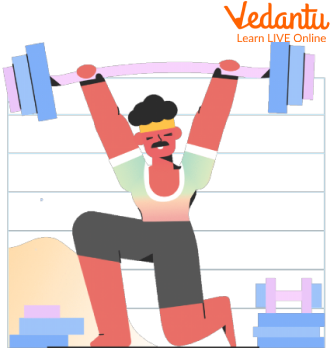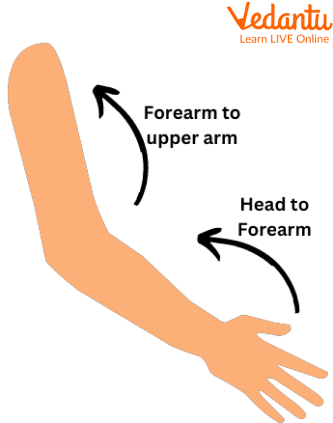




How Does the Arm Function? Explore Anatomy, Movements & Uses
A particular human upper limb: the area between the shoulder and wrist, something resembling an arm, such as a vertebrate animal's forelimb or an invertebrate animal's limb is the arm. There are three parts to it: the upper arm, forearm, and hand. It has 30 bones and stretches from the shoulder to the tips of the fingers. It also has numerous muscles, arteries, and veins, as well as nerves. Since we now know what an arm is, we should also be aware of its uses and functions. Don’t worry, these are discussed in the article below, let’s have a look.

Arm
Uses of Arms
Your arm muscles can assist you with small, exact motions (fine motor skills), like wiggling your fingers or fastening a button. Additionally, they let you make large actions like pushing yourself up or extending your arms above your head or straightening your elbow. Your arm has some muscles that are deeply embedded. They have a vast range of abilities, including the ability to touch, grip, feel, hold, manipulate, caress, and more. They play a crucial role in our identity and how we view ourselves. Arms have a very important role in our lives. We are able to grab things, why? Because we have arms. We are able to pick and throw things, why? Because we have arms. We do almost all basic chores with our arms. Arms are very crucial in our lives.

Uses of Arms
Function of Arms
Manipulation is the process through which humans manipulate other items using their arms and hands. The hand's primary function is to grab things. Other primates use their arms to walk along the ground or cling to trees to support themselves as they move about. They serve as a framework for the lymphatics, muscles, blood arteries, and nerves. The humerus is the only bone in the area of the upper arm. The two bones that make up the forearm are the radius and ulna. These two bones, the muscles and the nerves in our arms make the arm as a whole which has a very important role in supporting the lives of humans.

Arm’s Function
Which Three Components Make Up the Arm
The upper body's functional unit is the upper extremity or the Arm. There are three parts to it: the upper arm, forearm, and hand. It has 30 bones and stretches from the shoulder to the tips of the fingers. The upper limbs of the body are the arms. They are among the most intricate and utilised bodily parts.
There are four main components to each arm:
Upper arm
Forearm
Hand

Three Components Make Up the Arm
Summary
To conclude all the conceptual understanding regarding the Arm in this article, we can say that the upper body's functional unit is the upper extremity or the arm. There are three parts to it: the upper arm, forearm, and hand. It has 30 bones and stretches from the shoulder to the tips of the fingers. It also has numerous muscles, arteries, and veins, as well as nerves. We hope you enjoyed reading this article, in case of any other doubts, feel free to ask in the comments.
FAQs on Function of Arm: Importance, Movements & Everyday Examples
1. What are the main functions of our arms in daily life?
Our arms are essential for interacting with the world around us. Their primary functions include:
- Lifting and Carrying: Such as picking up a school bag or carrying groceries.
- Pushing and Pulling: Like opening a door or pulling a toy cart.
- Reaching and Holding: To grab objects from a shelf or hold a book.
- Writing and Drawing: Using our hands, which are supported and positioned by the arms.
- Support: Helping us balance or push ourselves up from a sitting or lying position.
2. What are the main parts of the human arm?
The human arm is made up of several key parts that work together. Starting from the top, these are the shoulder, the upper arm (the part between the shoulder and elbow), the elbow joint, the forearm (between the elbow and wrist), the wrist, and finally the hand with its fingers.
3. How is our arm connected to the rest of our body?
Our arm is connected to our body's torso at the shoulder. This connection is made possible by the shoulder joint, which links the main bone of the upper arm (humerus) to the shoulder blade (scapula). This special joint is what allows the arm to have a wide range of movement.
4. Why can we move our arms in so many directions, like in a full circle?
We can move our arms so freely because the shoulder has a special type of joint called a ball-and-socket joint. Imagine a ball fitting perfectly into a cup. This structure allows the arm to move forward, backward, sideways, and rotate, giving it the ability to swing in a full circle. This is different from a joint like our knee, which mostly moves in only one direction.
5. What helps our arms to move and become strong?
Our arms move because of muscles. These muscles are connected to the bones in our arms. When we want to move, our brain sends a signal to the muscles, causing them to tighten or relax. This pulls on the bones and makes the arm move. Activities like lifting objects, playing sports, and exercising help make these muscles, and our arms, stronger.
6. How do our arms and hands work together to perform tasks?
Our arms and hands work as a perfect team. The arm's main job is positioning and reaching. For example, your arm moves your hand to the right place to catch a ball or pick up a pencil. The hand and fingers then perform the fine, detailed movements like grasping, holding, and manipulating the object. Without the arm, the hand couldn't reach, and without the hand, the arm couldn't hold things properly.
7. Do our left and right arms perform the exact same functions?
While both arms are capable of the same basic functions like lifting and carrying, most people have a dominant arm. This is the arm that feels more natural and is more skilled for complex tasks like writing or throwing a ball. For right-handed people, this is the right arm, and for left-handed people, it is the left arm. Both arms, however, work together to provide balance and support each other in daily activities.









